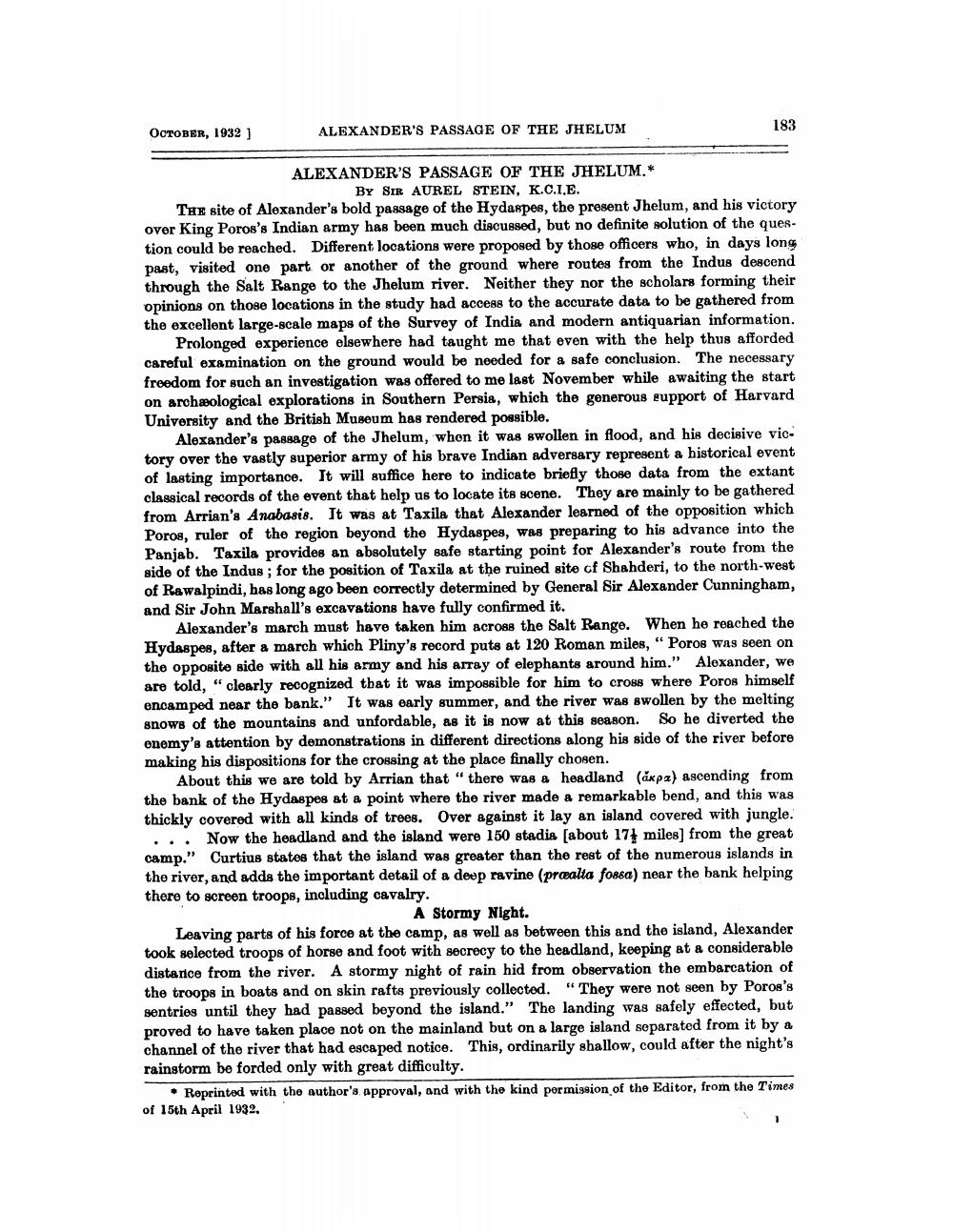________________
OCTOBER, 1932 ]
ALEXANDER'S PASSAGE OF THE JHELUM
183
ALEXANDER'S PASSAGE OF THE JHELUM.*
BY SIR AUREL STEIN, K.C.L.E. The site of Alexander's bold passage of the Hydanpes, the present Jhelum, and his victory over King Poros's Indian army has been much discussed, but no definite solution of the ques. tion could be reached. Different locations were proposed by those officers who, in days long past, visited one part or another of the ground where routes from the Indus descend through the Salt Range to the Jhelum river. Neither they nor the scholars forming their opinions on those locations in the study had access to the accurate data to be gathered from the excellent large-scale maps of the Survey of India and modern antiquarian information.
Prolonged experience elsewhere had taught me that even with the help thus afforded careful examination on the ground would be needed for a safe conclusion. The necessary freedom for such an investigation was offered to me last November while awaiting the start on archæological explorations in Southern Persia, which the generous eupport of Harvard University and the British Museum has rendered possible.
Alexander's passage of the Jhelum, when it was swollen in flood, and his decisive victory over the vastly superior army of his brave Indian adversary represent a historical event of lasting importance. It will suffice here to indicate briefly those data from the extant classical records of the event that help us to locate its scene. They are mainly to be gathered from Arrian's Anabasis. It was at Taxila that Alexander learned of the opposition which Poros, ruler of the region beyond the Hydaspes, was preparing to his advance into the Panjab. Taxila provides an absolutely safe starting point for Alexander's route from the side of the Indus; for the position of Taxila at the ruined site of Shahderi, to the north-west of Rawalpindi, has long ago been correctly determined by General Sir Alexander Cunningham, and Sir John Marshall's excavations have fully confirmed it.
Alexander's march must have taken him across the Salt Range. When he reached the Hydaspes, after a march which Pliny's record puts at 120 Roman miles, "Poros was seen on the opposite side with all his army and his array of elephants around him." Alexander, we are told,"clearly recognized that it was impossible for him to cross where Poros himself encamped near the bank." It was early summer, and the river was swollen by the melting snows of the mountains and unfordable, as it is now at this season. So he diverted the enemy's attention by demonstrations in different directions along his side of the river before making his dispositions for the crossing at the place finally chosen.
About this we are told by Arrian that "there was a headland (áxpz) ascending from the bank of the Hydaspes at a point where the river made a remarkable bend, and this was thickly covered with all kinds of trees. Over against it lay an island covered with jungle.
... Now the headland and the island were 150 stadia (about 174 miles from the great camp." Curtius states that the island was greater than the rest of the numerous islands in the river, and adds the important detail of a deep ravine (prealta fossa) near the bank helping there to screen troops, including cavalry.
A Stormy Night. Leaving parts of his force at the camp, as well as between this and the island, Alexander took selected troops of horse and foot with secrecy to the headland, keeping at a considerable distance from the river. A stormy night of rain hid from observation the embarcation of the troops in boats and on skin rafts previously collected." They were not seen by Poros's sentries until they had passed beyond the island." The landing was safely effected, but proved to have taken place not on the mainland but on a large island separated from it by a channel of the river that had escaped notice. This, ordinarily shallow, could after the night's rainstorm be forded only with great difficulty.
• Reprinted with the author's approval, and with the kind permission of the Editor, from the Times of 15th April 1932.




